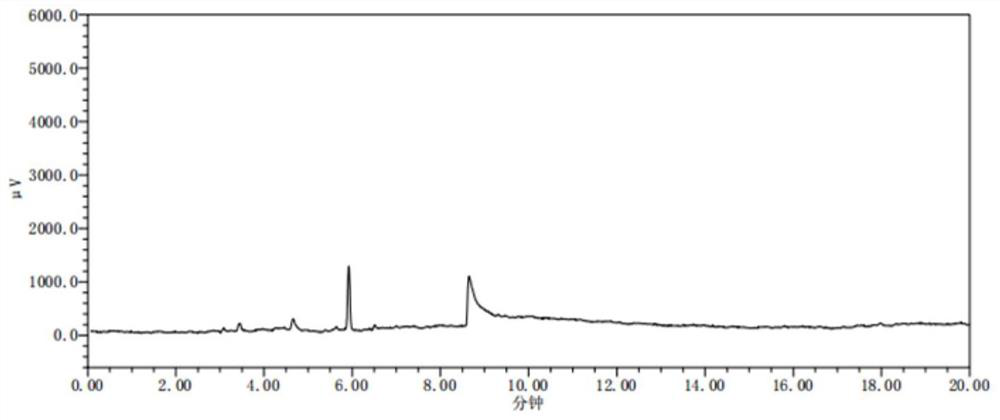Method for detecting benzene in ceftazidime residual solvent and application
A ceftazidime and residual solvent technology, which is applied to the detection and application field of benzene in ceftazidime residual solvent, can solve the problems of unloaded residual solvent detection methods and standards, and achieve the effects of good system adaptability, good specificity and good linearity
- Summary
- Abstract
- Description
- Claims
- Application Information
AI Technical Summary
Problems solved by technology
Method used
Image
Examples
Embodiment 1
[0051] (1) Chromatographic conditions:
[0052] Instrument: high-efficiency gas chromatograph (Shimadzu GC-2014C), the detector is a hydrogen flame ionization detector (FID);
[0053] Chromatographic column: DB-1, 30m×0.32mm, 1.0μm or equivalent capillary column;
[0054] Column temperature: the initial temperature is 50°C, maintain for 3 minutes, increase the temperature to 200°C at a rate of 10°C per minute, and maintain for 2 minutes;
[0055] The inlet temperature is 230°C; the detector temperature is 250°C;
[0056] The headspace equilibrium temperature is 90°C, and the equilibrium time is 30 minutes;
[0057] Air flow: 400mL / min; Hydrogen flow: 40mL / min; Column flow: 1.0mL / min;
[0058] Quantitative loop temperature: 140°C; transfer line temperature: 140°C;
[0059] Blank solvent: water.
[0060] (2) Solution preparation:
[0061] Table 1 Benzene solution preparation process
[0062]
[0063]
[0064] The specific operation is as follows:
[0065] The test ...
Embodiment 2
[0094] Verification Example 2: Linearity and Range
[0095] (1) Test process:
[0096] The preparation process of the linear solution is shown in Table 6 below (the preparation process of the benzene linear solution). Precisely measure 2 mL of the solution, put them into 20 mL headspace bottles, seal the cap, and inject the headspace sample. The linear solution (limit 10%) is the limit of quantification, and as the starting point of linearity, the concentration of each solution is taken as the abscissa, and the peak area of each solvent is used as the ordinate to carry out linear regression (see figure 2 ).
[0097] Table 6 Preparation process of benzene linear solution
[0098]
[0099]
[0100] The specific operation is as follows:
[0101] Linear stock solution: Take 20mg of benzene, put it in a 20mL measuring bottle, add N,N-dimethylacetamide to dissolve and dilute to the mark, shake well, quantitatively dilute with water to make a solution containing 0.4μg per...
Embodiment 3
[0114] Validation Example 3: Limits of Detection and Limits of Quantitation
[0115] (1) Test process:
[0116] Accurately measure the linear solution (limit 10%) under "Verification Example 2: Linearity and Range", the signal-to-noise ratio (S / N) is greater than 10:1, which can be used as the limit of quantification. Dilute the limit of quantitation, according to the signal-to-noise ratio (S / N) greater than 3:1, can be used as the detection limit. The quantitative limit was injected 6 times continuously, the peak area was recorded, and the average value and RSD value were calculated.
[0117] (2) Results and conclusions:
[0118] Table 8 Benzene quantitative limit and detection limit results
[0119]
[0120] Table 9 Benzene Quantitative Limit System Precision Results
[0121] Element 1 2 3 4 5 6 average RSD(%) benzene 972 846 902 986 985 1060 959 7.78
[0122] Table 10 Benzene quantitative limit recovery test result
[0123]
...
PUM
| Property | Measurement | Unit |
|---|---|---|
| recovery rate | aaaaa | aaaaa |
| recovery rate | aaaaa | aaaaa |
Abstract
Description
Claims
Application Information
 Login to View More
Login to View More - R&D Engineer
- R&D Manager
- IP Professional
- Industry Leading Data Capabilities
- Powerful AI technology
- Patent DNA Extraction
Browse by: Latest US Patents, China's latest patents, Technical Efficacy Thesaurus, Application Domain, Technology Topic, Popular Technical Reports.
© 2024 PatSnap. All rights reserved.Legal|Privacy policy|Modern Slavery Act Transparency Statement|Sitemap|About US| Contact US: help@patsnap.com










